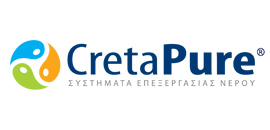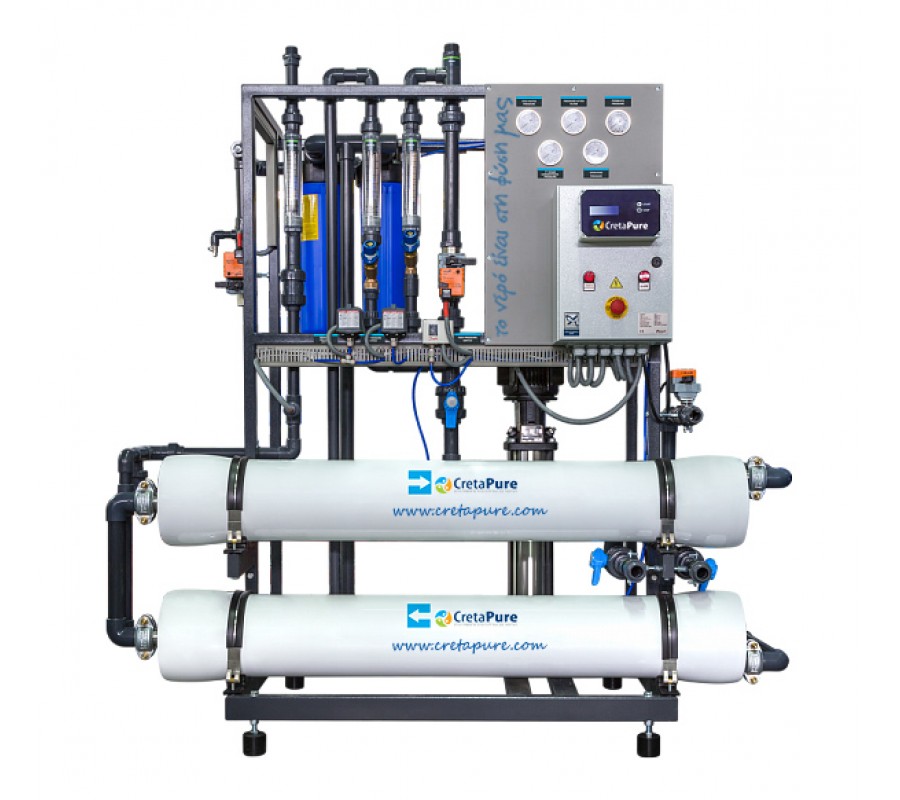Αφαλάτωση 48.000 λίτρα / ημέρα
Technical data
|
Capacity under the temperature 15°C1 |
m3/hour |
2 |
|
Number and type of membrane elements |
2 pcs |
Dow Filmtec™ XLE-440 |
|
Power supply |
400 V, 50 Hz |
|
|
Pump power |
kW |
3 |
|
Inlet pressure |
atm |
2...42 |
|
Operating pressure inside module |
atm |
10...14 |
|
Water consumption in service mode |
m3/hour |
2.8...3.6 |
|
Water consumption in hydraulic flushing mode |
m3/hour |
16...20 |
|
Connection port sizes:
|
DN40 DN25 DN32 |
|
|
System dimensions (H x W x D) |
mm |
1900x1700x1150 |
1 capacity of the reverse osmosis system depends on feed water composition and its temperature
2 stable pressure (+/- 0.5 bar) in the specified range is required for steady operation of the system
Feed water requirements
|
Temperature of feed water |
°С |
4...30 |
|
Residual chlorine, no more than |
mg/L |
0.1 |
|
Hardness, up to |
Meq/L |
3.0 (30.01) |
|
Iron, up to |
mg/L |
0.1 (0.51) |
|
Manganese, up to |
mg/L |
0.05 (0.11) |
|
Silicates, up to |
mg/L |
20.0 (250.01) |
|
Chemical oxygen demand, up to |
mg O2/L |
4.0 |
1 values with antiscalant dosing are given in brackets
Components of the system:
-
Dow Filmtec™ XLE membranes
-
Grundfos high-pressure pump
-
European solenoid valves
-
Multifunctional controller
-
Permeate conductivity sensor
-
Sediment filter
-
Low and high-pressure switch
-
Float switch
-
Regulated discharge and recycle flow meter
-
Vibration resistant pressure gauge
-
Frame with unique design
Optional:
-
Dow Filmtec™ ECO PRO and BW30HRLE membranes for problem water
-
Membrane rinse with permeate
-
Raw water blending
Operation of the industrial reverse osmosis system consists of the following stages of water purification.
Before osmosis, the feed water is pre-treated with 5-micron fine sediment cartridges coming with the system. Then the water is fed to the membrane module by high-pressure pump. During the treatment the water is divided into two flows inside the membrane module of the system: demineralized water, or permeate, and water with increased salt content, i.e. concentrate. Part of the concentrate is discharged into the sewage system while the module is operating, and part of it is sent to the inlet of a high-pressure pump, to recycle the concentrate. An antiscalant can be dosed into the feed water stream, which prevents the formation of deposits inside the membrane elements.
Demineralized water (permeate) is supplied to the storage tank of permeate, where a float switch is installed, which switches off the system when the tank is full. The system is automatically rinsed with feed water before it is switched off or at predetermined intervals. This mode is called the hydraulic flushing mode, during which the system requires a short-term 1-2 minutes water supply exceeding the water supply in service mode.
System controller provides:
-
Switching on and off of the system according to the level of water in the storage tank,
-
Automatic hydraulic flushing of membranes,
-
Blockings and preventive alarm in case of emergencies to protect the pump from dry running, membranes from high pressure etc.
-
Measurement and display of electric conductivity and temperature
Sediment cartridges are intended to protect membrane elements from non-dissolved impurities such as sand, clay particles etc. Delay in replacement of the cartridge might lead to damage or destruction of the membrane. In order to avoid such critical situations, we strongly recommend replace the cartridge at least once every 3 months.
If the quality of the treated water deteriorated, or system’s capacity decreased, it is necessary to conduct chemical cleaning of the reverse osmosis membrane with a CIP-station and special reagents. For the consistent quality of treated water, we recommend chemical cleaning of the reverse osmosis membrane at least twice a year.
In case you are not planning to employ the system for a long time, it is recommended to turn off water feed to the system and to preserve the membrane elements using a special preservative solution that will keep the membranes operational during the idle period.
It is recommended to keep technical service journal of the reverse osmosis system and a log book of the system performance and water quality. The availability of the history will lead to timely replacement of cartridges, chemical cleaning of membranes and other maintenance operations connected to the system service.
Αφαλάτωση 48.000 λίτρα / ημέρα.
Industrial reverse osmosis system Creta Pure MO—2 with a capacity of 2-3 m3/h is intended for demineralization of salts containing water. The process of demineralization is carried out with Dow Filmtec™ (USA) reverse osmosis membrane elements.
During the treatment the water is divided into two flows inside the membrane module of the system: demineralized water, or permeate, and water with increased salt content, i.e. concentrate. The concentrate is discharged into the sewage system while the module is operating, and part of it is sent to the inlet of a high-pressure pump, to recycle the concentrate. The recycle rate enables control of the volume of concentrate discharge. The recycle can be adjusted to achieve a permeate rate up to 75%.
The system automation provides protection of the pump against dry running, protection of the membranes from high pressure, ensures the system is switched on and off according to the level of permeate in the permeate tank, and automatically performs hydraulic flushing of the membranes with feed water or permeate.
Key advantages:
-
High quality of the components and thorough engineering approach
-
Energy saving with the application of Dow Filmtec™ XLE membrane elements and Grundfos pumps
-
Individual engineering evaluation for every project
-
Variable parameters of operation due to availability of control valves
-
Manufacturing process is certified according to the ISO 9001:2009 standard
-
Produced since 1999
-
CE marked and confirmed to be safe in accordance with the EU new approach directives


